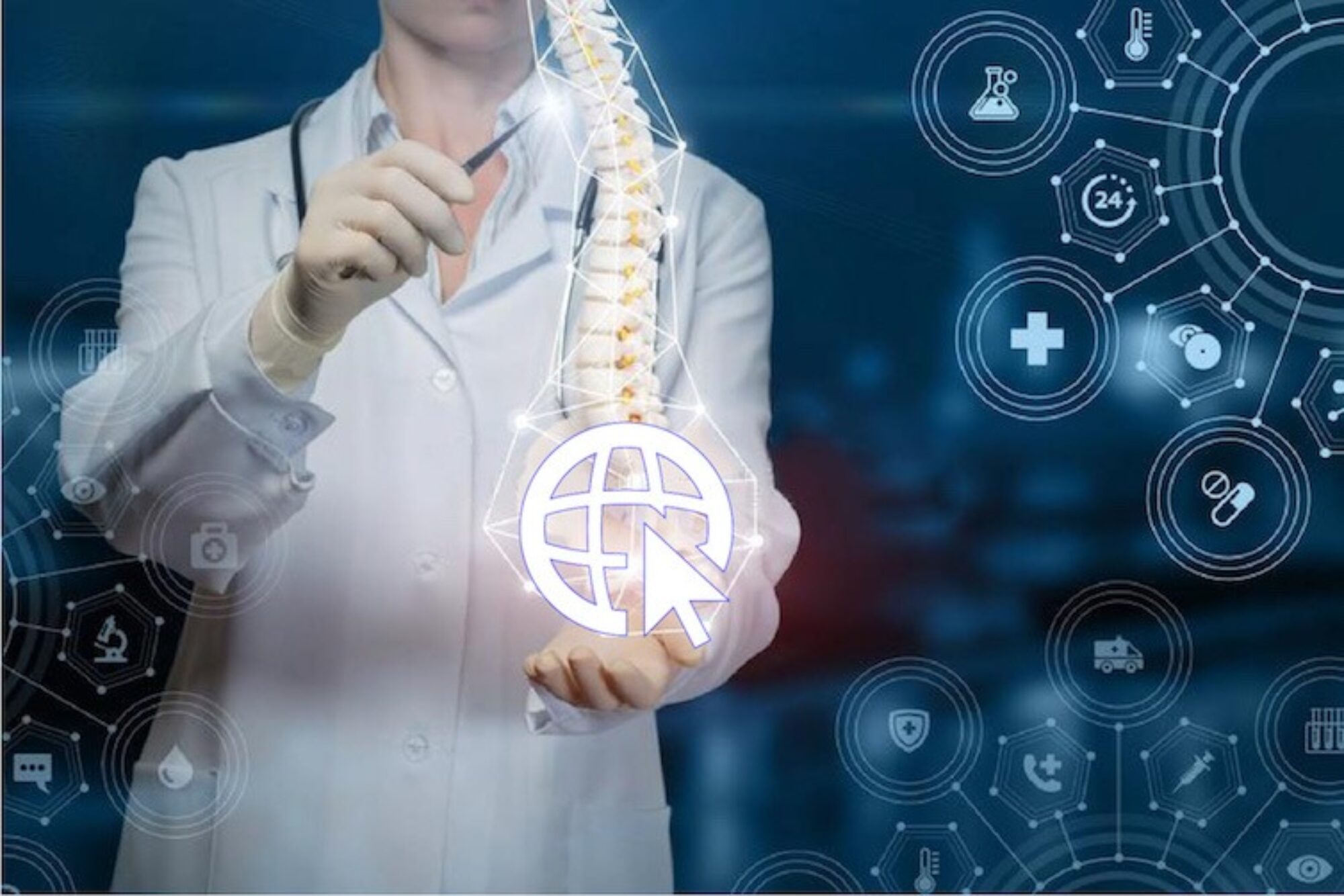Basion-dens interval (BDI) and Translational BDI (tBDI) – Radiology Measurements of the Craniocervical Junction
BDI Research – Multiple papers, most case studies (not so good in terms of scientific levels of evidence) but BDI is widely utilized world-wide by neurosurgeons.
BDI is due mainly to atlanto-occipital dissociation (AOD), which can include dislocation and subluxation, multiple research papers have been conducted on the subject. However, most of these are case studies and are regarded as third place regarding the level of evidence.
Also, dynamic flexion and extension (tBDI) imaging studies are just emerging. SBA will be monitoring and will post relevant new dynamic imaging studies on this site. See below for the latest study dated January 2023.
Is BDI a widely utilized radiology measurement?
Yes, basion-dens interval (BDI) is a widely utilized measurement by Neurosurgeons. For example:
Basion-dens interval (BDI), originally described by Wholey et al,4 as well as the basion-axial interval (BAI). Harris et al2 calculated that >95% of adults in their study population had a BDI and BAI less than 12 mm and considered this value as the upper limit of normal.
Canadian Neurosurgery: “Based on our systematic review, we recommend that the CXA, Harris measurement (BDI & BAI), Grabb-Mapstone-Oakes measurement, and the angular displacement of C1 to C2 be used to evaluate suspected CCI in EDS patients. Surgical fixation of suspected CCI should only be performed in cases with clear radiographic presence of instability and concordant symptoms/signs. Consensus-based guidelines and care pathways are required.” (Canada). Reference
What part of my body involves the basion-dens interval (BDI)?
The basion-dens interval (BDI) is the distance between two points in your neck: the basion and the tip of the dens. Doctors use this measurement to check for injuries in the neck area. The basion is a point at the base of your skull, and the dens is a projection of a bone in your neck.
What can disturb the regular basion-dens interval (BDI)?
Any condition causing atlanto-occipital dissociation can also affect the BDI. The atlanto-occipital joint is the link between the first vertebrae (atlas) and the base of the skull (occiput).
Common causes include:
High-energy trauma: This type of injury is most commonly caused by high-energy trauma with hyperextension of the skull, such as car accidents.
Age: Children and young adults are more frequently affected due to specific anatomical predispositions. An atlanto-occipital dislocation occurs five times more commonly in children than adults.
What are the typical symptoms associated with abnormal BDI?
If you indeed have an abnormality of the BDI, then you could experience the following symptoms:
Motor or sensory neurological deficiencies: This can include weakness or loss of sensation in the arms or legs.
Cranial nerve deficiencies: This can affect vision, hearing, and facial movements.
Cervical-medullary syndrome: This can cause various symptoms, such as difficulty swallowing, hoarseness, and weakness in the arms or legs
What Diagnostic Imaging is Utilized to examine BDI ?
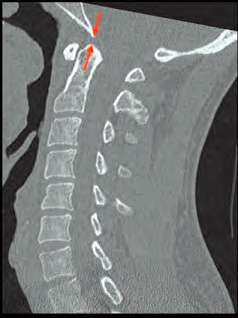
With the recent studies, showing the superiority of Craniocervical Instability even in adults, use of (CBCT or) CT (Figure 1) with assessment of CCI may become the standard criteria for diagnosing occipitocervical dissociation (OCD) in the future [9•]
BDI measurement can be obtained on MRI, however the measurement is not accurate as MRIs are best for visualizing soft tissues, not bony structures; none-the-less, MRIs can provide a “thumb guide” to roughly assess BDI and other measurements and indicate if CT is suggested for further investigation.
MRI generally demonstrates increased T2-weighted signal intensity within the occiput-C1 and C1-C2 articulations [7, 10, 30]. Definitive evidence of disruption of the alar and tectorial ligaments can sometimes be seen, although making this determination may be difficult.
Evaluation of the spinal cord and brainstem parenchyma may reveal injuries ranging from mild edema and increased T2-weighted signal intensity to the presence of intraspinal hematoma or even transection.
Epidural fluid collections representing hematoma or cerebrospinal fluid are commonly seen, as is the presence of subdural hematoma. Extensive soft tissue swelling extending to the occipitocervical finding is a universal finding and is easily identified on MRI. Reference
Lateral XRay imaging can also be used for measuring BDI, however, like MRI, the quality of the image is low and the measurement should be used as a preliminary exam to determine if further investigation using CBCT/CT is advised.
Last but not least, supine or imaging in neutral position can be helpful in assessing or ruling out atlanto-occipital dissociation (AOD), however, relatively new dynamic imaging can be helpful to completely rule out AOD because a patient can have an abnormal BDI in just one position e.g. normal BDI in neck extension and neutral, but an abnormal BDI in the neck flexion position. However, more high level of evidence studies is needed in dynamic imaging regarding BDI measurements and in diagnostic imaging in general. See additional information on Dynamic Diagnostic Imaging here.
What does the radiology measurement Basion-dens Interval (BDI) aim to help rule out?
Atlanto-occipital dissociation (AOD) (i.e. base of skull to first vertebrae) injuries include both atlanto-occipital dislocations and atlanto-occipital subluxations (i.e. instability).
Although dislocations are usually fatal, subluxations are rarely fatal but occur with less frequency than dislocations.1 Harris et al2,3 established a reliable and accepted means to diagnose atlanto-occipital dissociations on the contact lateral cervical spine radiograph.
How do Radiologists measure BDI?
The basion-dens interval (BDI) is the distance between the basion and the tip of the dens, used in the diagnosis of atlanto-occipital dissociation injuries.
Normal values for adults are less than 12 mm on an XRay and less than 8.5 mm on CT . In children, greater than 10 mm may suggest atlanto-occipital injury. Reference.
*Note: Some Neurosurgeons consider ≥ 10 mm in adults as pathological/abnormal.
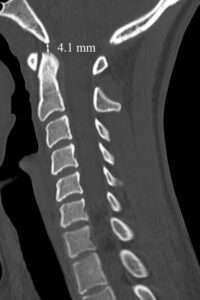
Translational BDI (tBDI) / Dynamic BDI Flexion-Extension Measurement
IMPORTANT NOTE: THIS MEASUREMENT IS NOT WIDELY ACCEPTED AND NOT COMMONLY USED. THE USE OF tBDI AS A MEASUREMENT TOOL FOR NEUROSURGEONS IS STILL A TOPIC OF DEBATE IN THE MEDICAL COMMUNITY, AND MORE RESEARCH IS NEEDED TO CONFIRM ITS DIAGNOSTIC ACCURACY AND RELIABILITY.
“Cousin” to the BDI measurement, but in reference to dynamic imaging (flexion and extension), the measurement translational BDI (t-BDI), as mentioned by Neurosurgeon, Dr. Henderson “When possible, the Harris measurement, BDI is made from the MRI or CT in both flexion and extension to assess translation (sliding movement) between flexion and extension.
Horizontal Harris Measurement (HHM): a measurement of > 12 mm represents craniocervical instability. If the HHM changes by > 2 mm between flexion and extension, then craniocervical instability is inferred.”
Also, in a recent January 2023 Australian study called “Establishment of CCJ measurements (Reference Values) for Measures of Craniocervical Stability Using Upright Dynamic Radiography: Summary of Study Findings“, it states “the Basion-dens interval (BDI) and Grabb Oakes Line measurements did not exhibit a statistically significant difference when switching from neutral to flexion.
The study indicated normal BAI Ranges:
- Neutral: 1 mm – 9.5 mm
- Flexion: 0.5 mm – 11.0 mm
- Extension: 0.0mm – 8.5 mm
What treatment options are available for abnormal BDI?
This depends upon the severity and cause of the abnormality. The treatment options include:
Quick diagnosis: It is essential for your physician to quickly diagnose the injury to minimize the risk of further harm to you.
Immobilization: Your physician may use a particular device, such as a neck brace, to keep the head and neck still to prevent further injury.
Surgery: In some cases, surgery may be needed to fuse the bones in the neck and head together to provide stability.
Breathing support: In severe cases, patients may need help breathing, so they are admitted into an ICU where their doctor may use a tube to help them breathe.
The following chart is from SBA’s 2nd Radiology Report Summary of Outcomes ending December 2022. 14% of the participants had an abnormal BDI measurement and 10% had an abnormal t-BDI measurement. For the full report, click here.
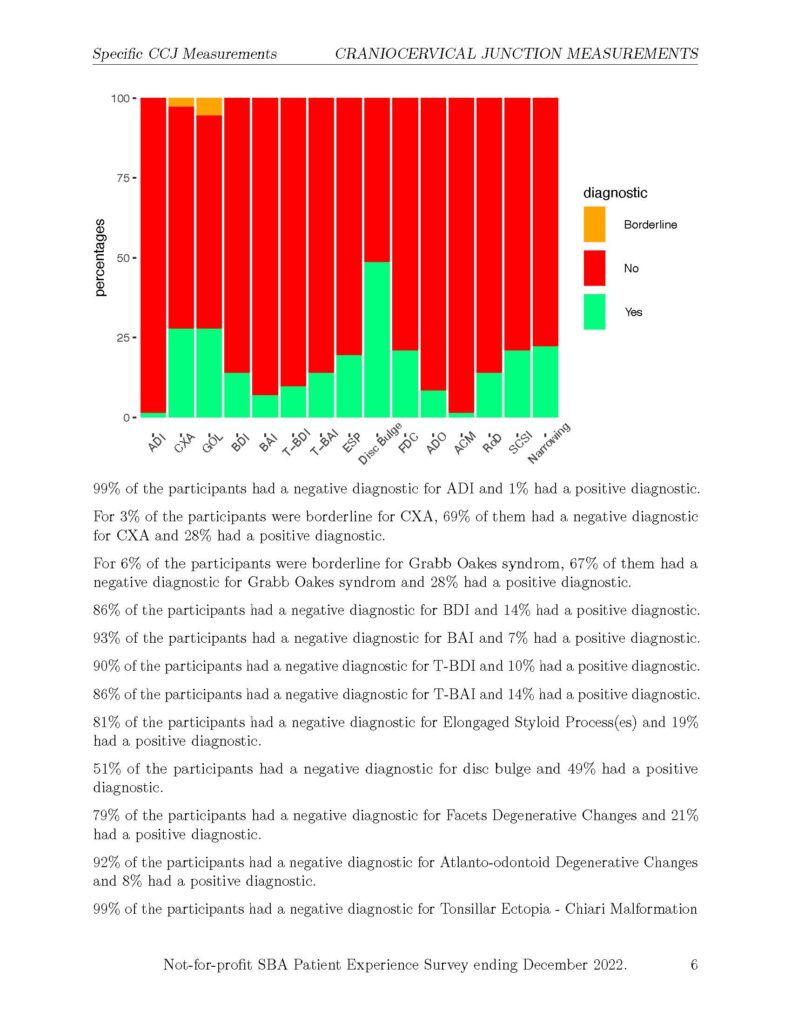
In the CCJ Patient Experience Summary Report ending December 2022 reported, 18% reported they had an abnormal BDI measurement and 8% reported they were told they had an abnormal BDI measurement but did not receive the measurement. To review the full report, click here.
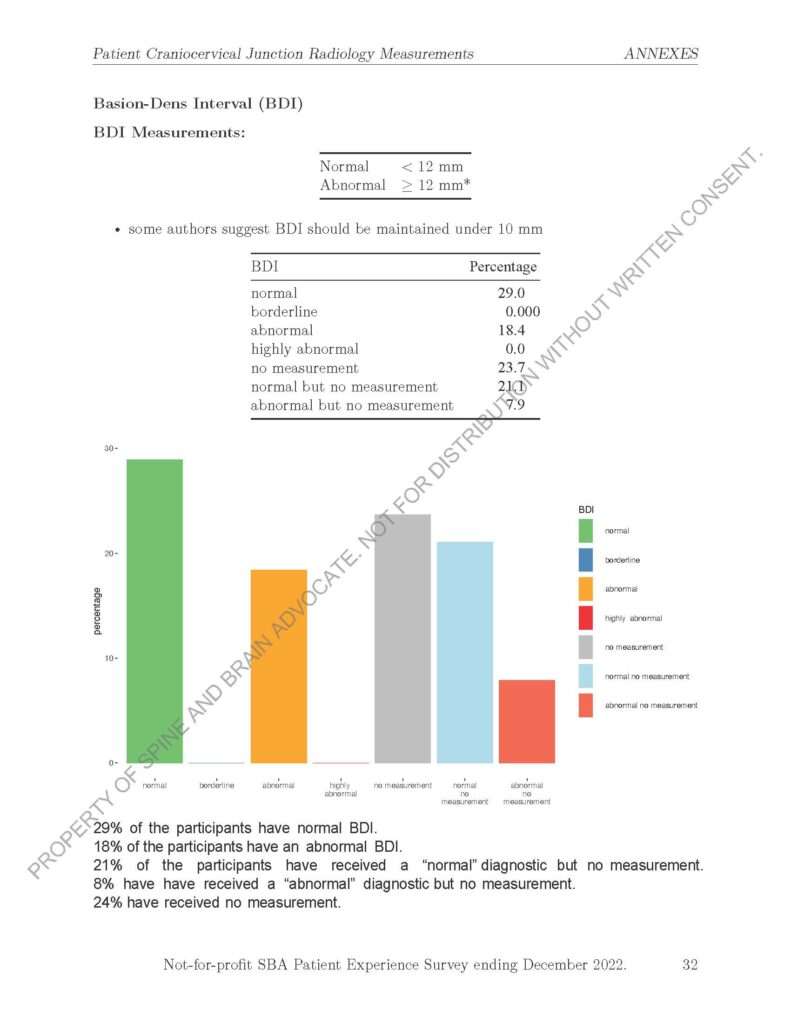
ADDITIONAL REFERENCES
- Hacking C. Basion-dens interval | Radiology Reference Article | Radiopaedia.org [Internet]. Radiopaedia. [cited 2023 Apr 30]. Available from: https://radiopaedia.org/articles/basion-dens-interval
- Hacking C. Basion-axial interval | Radiology Reference Article | Radiopaedia.org [Internet]. Radiopaedia. [cited 2023 Apr 30]. Available from: https://radiopaedia.org/articles/basion-axial-interval-1
- Hosalkar HS, Cain EL, Horn D, Chin KR, Dormans JP, Drummond DS. Traumatic atlanto-occipital dislocation in children. J Bone Joint Surg Am. 2005 Nov;87(11):2480–8.
- Vachata P, Bolcha M, Lodin J, Sameš M. Atlanto-occipital dissociation. Rozhl V Chir Mesicnik Ceskoslovenske Chir Spolecnosti. 2020;99(1):22–8.
- Atlanto-axial instability (AAI): What you need to know [Internet]. Massachusetts General Hospital. [cited 2023 Apr 30]. Available from: https://www.massgeneral.org/children/down-syndrome/atlantoaxial-instability-aai
- Holy M, Szigethy L, Joelson A, Olerud C. A Novel Treatment of Pediatric Atlanto-Occipital Dislocation with Nonfusion Using Muscle-Preserving Temporary Internal Fixation of C0-C2: Case Series and Technical Note. Journal of Neurological Surgery Reports. 2023 Jan;84(01):e11-6.
- Lepard JR, Reed LA, Theiss SM, Rajaram SR. Unilateral atlantooccipital injury: A case series and detailed radiographic description. Journal of Craniovertebral Junction and Spine. 2022 Jul 1;13(3):344.
- Wathen C, Ghenbot Y, Chauhan D, Schuster J, Petrov D. Management of Traumatic Atlantooccipital Dissociation at a Level 1 Trauma Center: A Retrospective Case Series. World Neurosurgery. 2023 Feb 1;170:e264-70.
- García-Pérez D, Panero I, Lagares A, Gómez PA, Alén JF, Paredes I. atlanto-occipital dislocation with concomitant severe traumatic brain injury: A retrospective study at a level 1 trauma centre. Neurocirugía (English Edition). 2023 Jan 1;34(1):12-21.
Shop 2nd Radiology Opinion Services and Products
Important Note: Having access to medical information is a powerful thing and an important part of advocating for your healthcare. However, this website should never replace advice from your physician who understands your specific medical history and is trained to care for patients.
If you have any suggestions or see any errors on this page, please contact us.
SBA Thanks Professor of Medical Education, Dr. A. Bohari for contributing to this page.
